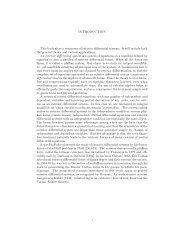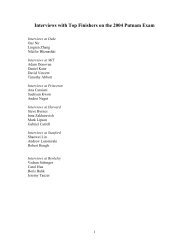You also want an ePaper? Increase the reach of your titles
YUMPU automatically turns print PDFs into web optimized ePapers that Google loves.
54 ALEXANDER BARVINOK AND GRIGORIY BLEKHERMAN<br />
For any k ≥ 2, the situation is much more complicated: the membership<br />
problem for Pos2k,n:<br />
given a polynomial, decide whether it belongs to Pos2k,n,<br />
is NP-hard, which indicates that the facial structure <strong>of</strong> Pos2k,n is probably hard<br />
to describe.<br />
Example 1.3 (<strong>Convex</strong> hulls <strong>of</strong> Grassmannians and calibrations). Let<br />
Gm(Rn ) be the Grassmannian <strong>of</strong> all oriented m-dimensional subspaces <strong>of</strong> Rn ,<br />
n > 1. Let us consider Gm(Rn ) as a subset <strong>of</strong> Vm,n = �m n R via the Plücker<br />
embedding. Namely, let e1,...,en be the standard basis <strong>of</strong> Rn . We make Vm,n<br />
a Euclidean space by choosing an orthonormal basis ei1 ∧ · · · ∧ eim for 1 ≤ i1 <<br />
· · · < im ≤ n. Thus the coordinates <strong>of</strong> a subspace x ∈ Gm(Rn ) are indexed by<br />
m-subsets 1 ≤ i1 < i2 < · · · < im ≤ n <strong>of</strong> {1,...,n} and the coordinate xi1,...,im<br />
is equal to the oriented volume <strong>of</strong> the parallelepiped spanned by the orthogonal<br />
projection <strong>of</strong> e11 ,...,eim onto x. This identifies Gm(Rn ) with a subset <strong>of</strong> the<br />
unit sphere in Vm,n. The convex hull B = conv (Gm(Rn )), called the unit mass<br />
ball, turns out to be <strong>of</strong> interest in the theory <strong>of</strong> calibrations and area-minimizing<br />
surfaces: a face <strong>of</strong> B gives rise to a family <strong>of</strong> m-dimensional area-minimizing<br />
surfaces whose tangent planes belong to the face, see [Harvey and Lawson 1982]<br />
and [Morgan 1988]. The comass <strong>of</strong> a linear functional ℓ : Vm,n → R is the<br />
maximum value <strong>of</strong> ℓ on Gm(Rn ). A calibration is a linear functional ℓ : Vm,n → R<br />
<strong>of</strong> comass 1. The polar B◦ is called the unit comass ball.<br />
One can easily view Gm(Rn ) as an orbit. We let G = SO(n), the group<br />
<strong>of</strong> orientation-preserving orthogonal transformations <strong>of</strong> Rn , and consider the<br />
action <strong>of</strong> SO(n) in Vm,n by the m-th exterior power <strong>of</strong> its defining action in Rn .<br />
Choosing v = e1 ∧ · · · ∧ em, we observe that Gm(Rn ) is the orbit {gv : g ∈ G}.<br />
It is easy to see that dimconv � Gm(Rn ) � = � � n<br />
m .<br />
This example was suggested to the authors by B. Sturmfels and J. Sullivan.<br />
The facial structure <strong>of</strong> the convex hull <strong>of</strong> Gm(R n ) is understood for m ≤ 2, for<br />
m ≥ n − 2 and for some special values <strong>of</strong> m and n, see [Harvey and Lawson<br />
1982], [Harvey and Morgan 1986] and [Morgan 1988]. If m = 2, then the faces<br />
<strong>of</strong> the unit mass ball are as follows: let us choose an even-dimensional subspace<br />
U ⊂ R m and an orthogonal complex structure on U, thus identifying U = C 2k<br />
for some k. Then the corresponding face <strong>of</strong> conv (Gm(R n )) is the convex hull <strong>of</strong><br />
all oriented planes in U identified with complex lines in C 2k .<br />
In general, it appears to be difficult to describe the facial structure <strong>of</strong> the unit<br />
mass ball. The authors do not know the complexity status <strong>of</strong> the membership<br />
problem for the unit mass ball:<br />
given a point x ∈ � m R n , decide if it lies in conv (Gm(R n )),<br />
but suspect that the problem is NP-hard if m ≥ 3 is fixed and n is allowed to<br />
grow.




